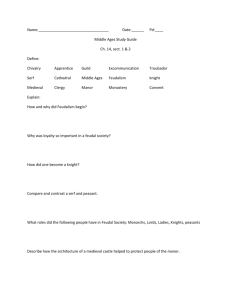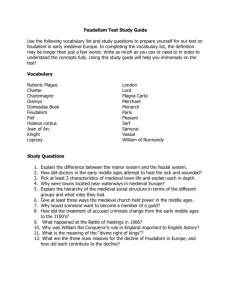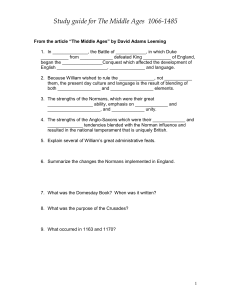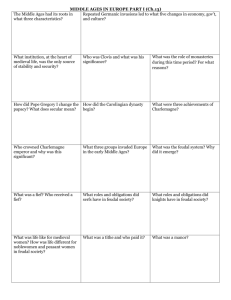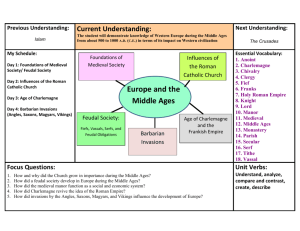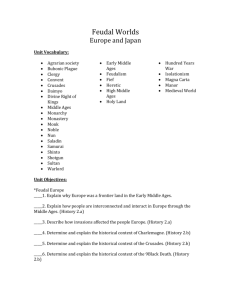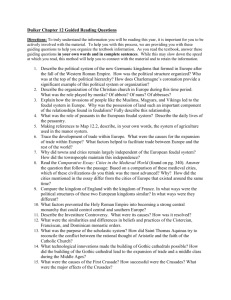Week 11 Chapter 10 homework
advertisement
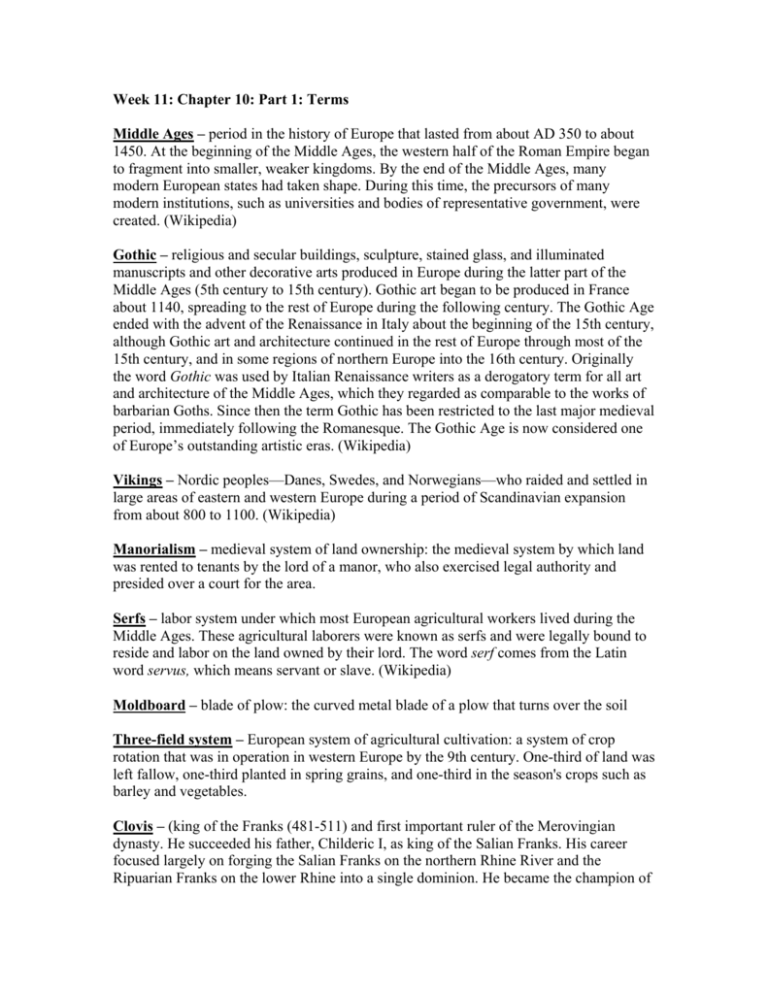
Week 11: Chapter 10: Part 1: Terms Middle Ages – period in the history of Europe that lasted from about AD 350 to about 1450. At the beginning of the Middle Ages, the western half of the Roman Empire began to fragment into smaller, weaker kingdoms. By the end of the Middle Ages, many modern European states had taken shape. During this time, the precursors of many modern institutions, such as universities and bodies of representative government, were created. (Wikipedia) Gothic – religious and secular buildings, sculpture, stained glass, and illuminated manuscripts and other decorative arts produced in Europe during the latter part of the Middle Ages (5th century to 15th century). Gothic art began to be produced in France about 1140, spreading to the rest of Europe during the following century. The Gothic Age ended with the advent of the Renaissance in Italy about the beginning of the 15th century, although Gothic art and architecture continued in the rest of Europe through most of the 15th century, and in some regions of northern Europe into the 16th century. Originally the word Gothic was used by Italian Renaissance writers as a derogatory term for all art and architecture of the Middle Ages, which they regarded as comparable to the works of barbarian Goths. Since then the term Gothic has been restricted to the last major medieval period, immediately following the Romanesque. The Gothic Age is now considered one of Europe’s outstanding artistic eras. (Wikipedia) Vikings – Nordic peoples—Danes, Swedes, and Norwegians—who raided and settled in large areas of eastern and western Europe during a period of Scandinavian expansion from about 800 to 1100. (Wikipedia) Manorialism – medieval system of land ownership: the medieval system by which land was rented to tenants by the lord of a manor, who also exercised legal authority and presided over a court for the area. Serfs – labor system under which most European agricultural workers lived during the Middle Ages. These agricultural laborers were known as serfs and were legally bound to reside and labor on the land owned by their lord. The word serf comes from the Latin word servus, which means servant or slave. (Wikipedia) Moldboard – blade of plow: the curved metal blade of a plow that turns over the soil Three-field system – European system of agricultural cultivation: a system of crop rotation that was in operation in western Europe by the 9th century. One-third of land was left fallow, one-third planted in spring grains, and one-third in the season's crops such as barley and vegetables. Clovis – (king of the Franks (481-511) and first important ruler of the Merovingian dynasty. He succeeded his father, Childeric I, as king of the Salian Franks. His career focused largely on forging the Salian Franks on the northern Rhine River and the Ripuarian Franks on the lower Rhine into a single dominion. He became the champion of orthodox Christians in every part of Gaul and was supported effectively by the church in all his campaigns. He continued to fight the Alamanni, who were completely conquered by 506; the next year the Visigoths were decisively defeated when their king, Alaric II, was killed by Clovis in a battle near Poitiers. Clovis made Paris the capital of the Frankish kingdom, which at that time included most of present-day France and southwestern Germany. According to Salian custom, he divided his kingdom among his four sons. (Wikipedia) Carolingians – sometimes called Carlovingian, second dynasty of Frankish kings who ruled parts of Western Europe from the 7th to the 10th centuries. (Wikipedia) Charles Martel – (688?-741), Carolingian ruler of the Frankish kingdom of Austrasia (in present northeastern France and southwestern Germany). Charles drove the Muslims out of the Rhône valley in 739, when they had again advanced into France as far as Lyon, leaving them nothing of their possessions north of the Pyrenees beyond the Aude River. Charles died in Quierzy, on the Oise River, leaving the kingdom divided between his two sons, Carloman and Pepin the Short.(Wikipedia) Charlemange – (742?-814), in Latin Carolus Magnus (Charles the Great), king of the Franks (768-814) and emperor of the Romans (800-814). During his reign, Charlemagne built a kingdom that included almost all of western and central Europe and he presided over a cultural and legal revival that came to be known as the Carolingian Renaissance. His empire did not long survive his death, but its two main territories, East and West Francia, later became the major parts of two important European entities: West Francia became modern-day France, and East Francia became first the Holy Roman Empire and then the modern state of Germany. Charlemagne’s close alliance with the popes, the leaders of the Roman Catholic Church, also established a precedent for subsequent ties between medieval popes and kings. (Wikipedia) Holy Roman Emperors – Emperors in northern Italy and Germany following the split of Charlemagne’s empire; claimed title of emperor c. 10th century; failed to develop centralized monarchy in Germany. Feudalism – contractual system of political and military relationships existing among members of the nobility in Western Europe during the High Middle Ages. Feudalism was characterized by the granting of fiefs, chiefly in the form of land and labor, in return for political and military services—a contract sealed by oaths of homage and fealty (fidelity). The grantor was lord of the grantee, his vassal, but both were free men and social peers. Feudalism joined political and military service with landholding to preserve medieval Europe from disintegrating into myriad independent seigneuries after the fall of the Carolingian Empire. (Wikipedia) Vassals – dependent landholder in feudal society: somebody who gave loyalty and homage to a feudal lord and received the right to occupy the lord's land and be protected by him. Members of the military elite in the Middle Ages who received land or a benefice from a lord in return for military service and loyalty. (Encarta) Capetians - medieval French ruler: a member of the royal dynasty founded by Hugh Capet that ruled France from AD 987 to 1328. of Capetians: relating to the Capetians or the period of their rule. (Encarta) William the Conqueror – William I (of England), called The Conqueror (1027-1087), first Norman king of England (1066-1087), who has been called one of the first modern kings and is generally regarded as one of the outstanding figures in western European history. (Wikipedia) Magna Carta – (Latin, “Great Charter”), document sealed by King John of England on June 15, 1215, in which he made a series of promises to his subjects that he would govern England and deal with his vassals according to the customs of feudal law. Over the course of centuries, these promises have required governments in England (and in countries influenced by English tradition) to follow the law in dealing with their citizens. The Magna Carta remains a major document in the history of individual liberty. The document establishes the principle that no person, not even the king, is above the law. More specifically, this means that the government must follow its own laws in its dealings with its citizens, just as citizens must obey the law in their dealings with other citizens. (Wikipedia) Parliaments – Bodies representing privileged groups; institutionalized feudal principle that rulers should consult with their vassals; found in England, Spain, Germany, and France. Hundred Years War – armed conflict between France and England during the years from 1337 to 1453. The Hundred Years’ War was a series of short conflicts, broken intermittently by a number of truces and peace treaties. It resulted from disputes between the ruling families of the two countries, the French Capetians and the English Plantagenets, over territories in France and the succession to the French throne. (Wikipedia) Pope Urban II – (1040?-1099), pope (1088-1099), whose proclamation of the First Crusade marked the papacy's assumption of the leadership of Western Christendom. (Wikipedia) St. Clare of Assisi – (1194-1253), Italian nun, born in Assisi of a rich and noble family. In 1211 she heard the Italian monk and preacher St. Francis of Assisi preach, and, inspired by his eloquence, she entered the Order of the Franciscans the following year. With the help and advice of St. Francis and despite the opposition of her family, she founded the order of Franciscan nuns known as the Order of the Poor Ladies, commonly called Poor Clares. Clare was canonized in 1255. Her feast day is August 11. (Wikipedia) Gregory VII - (circa 1020-85), pope (1073-85), one of the great reformers of the medieval church. He asserted the primacy of the church over secular powers and led the papal party in the first phase of its conflict with the Holy Roman Empire. (Wikipedia) Peter Abelard – (1079-1142?), French philosopher and theologian, whose fame as a teacher made him one of the most celebrated figures of the 12th century. (Wikipedia) St. Bernard of Clairvaux – (1090-1153), French ecclesiastic, born near Dijon. In 1113 he became a monk in the Cistercian monastery of Cîteaux, a small village south of Dijon, and in 1115 he became abbot of a monastery at Clairvaux, north of Dijon. Under his rule the monastery at Clairvaux became the most prominent of the Cistercian order. Reputed miracles and the eloquent preaching of Bernard attracted numerous pilgrims. Between 1130 and 1145, more than 90 monasteries were founded under the auspices of the one at Clairvaux, and Bernard's influence in the Roman Catholic church spread throughout the world. He is reputed to have established the rule of the Order of Knights Templar, and in 1128 he obtained recognition of the order from the church. In the contest between Pope Innocent II and Antipope Anacletus II for the papacy, Bernard was instrumental in the victory of Innocent. In 1146, at the command of the pope, Bernard began his preaching of the Second Crusade. His sermon, delivered at Vézelay, aroused enthusiasm throughout France; Louis VII, king of France, was persuaded to join the Crusade, and subsequently Bernard gained recruits from northern France, Flanders, and Germany. The failure of the Crusade was a great blow to him. He was canonized in 1174 and named Doctor of the Church in 1830. His feast day is August 20. (Wikipedia) Thomas Aquinas – sometimes called the Angelic Doctor and the Prince of Scholastics (1225-1274), Italian philosopher and theologian, whose works have made him the most important figure in Scholastic philosophy and one of the leading Roman Catholic theologians. (Wikipedia) Scholasticism – philosophic and theological movement that attempted to use natural human reason, in particular, the philosophy and science of Aristotle, to understand the supernatural content of Christian revelation. It was dominant in the medieval Christian schools and universities of Europe from about the middle of the 11th century to about the middle of the 15th century. The ultimate ideal of the movement was to integrate into an ordered system both the natural wisdom of Greece and Rome and the religious wisdom of Christianity. The term Scholasticism is also used in a wider sense to signify the spirit and methods characteristic of this period of thought or any similar spirit and attitude toward learning found in other periods of history. The term Scholastic, which originally designated the heads of the medieval monastic or cathedral schools from which the universities developed, finally came to be applied to anyone teaching philosophy or theology in such schools or universities. Troubadours – (Provençal trobar,”to find” or “to invent”), lyric poets and poetmusicians who flourished in France from the end of the 11th century to the end of the 13th century. The troubadours, who were active in Province in southern France, took their inspiration from the ancient Greek conception of the lyric poem as a vocal composition. Written in the Provençal language, the lyrics of the troubadours were among the first to use native language rather than Latin, the literary language of the Middle Ages. These poems incorporated new forms, melodies, and rhythms, either original or borrowed, from the informal music of the people. The earliest troubadour whose works have been preserved was Guillaume IX of Aquitaine (1071-1127). Of the more than 400 troubadours known to have lived, the majority were nobles and some were kings; for them, composing and performing songs was a manifestation of the ideal of chivalry. Troubadour music gradually disappeared during the 13th century as the courts of southern France were destroyed in the religious wars that ended in the defeat of the Albigenses by the papal power. (Wikipedia) Hanseatic League - A former economic and defensive confederation of free towns in northern Germany and neighboring areas. Traditionally dated to a protective alliance formed by Lübeck and Hamburg in 1241, it reached the height of its power in the 14th century and held its last official assembly in 1669. (http://www.answers.com/topic/hanseatic-league) The Hanseatic League was not so much a league of cities as it was a league of merchant associations within the cities of Northern Germany and the Baltic. Trade in the middle ages was a dangerous and risky business and the only way for merchants to protect themselves was by traveling together. This banding together of merchants on the road led to their alliances at home as well. In the case of the Hanseatic League the impetus for its formation was trade along the Kiel "salt road" which did not run between Kiel and Luebeck, but between Hamburg and Lubeck but was named after the town where the salt was mined. (http://members.bellatlantic.net/~baronfum/hansa.html) Jacques Coeur – (1395?-1456), French merchant and banker who was ennobled by King Charles VI for his service. Coeur was born the son of a merchant, and he learned to gain from every opportunity for profit that presented itself. First he speculated on the money exchange, and then traveled to the countries of the eastern Mediterranean Sea to conduct commerce. Coeur also knew how to make himself indispensable to the French king, Charles VII (ruled 1422-1461), and how to further his own enterprises through his political functions. Guilds – association of persons who have similar interests in a craft, business, or profession; the purpose of the association is mutual aid and protection. The term is particularly applied to two types of such association that flourished in continental Europe and England during the Middle Ages: the merchant guild or guild merchant, and the craft guild, sometimes known as the trade guild or trade corporation. Black Death - outbreak of bubonic plague that struck Europe and the Mediterranean area from 1347 through 1351. It was the first of a cycle of European plague epidemics that continued until the early 18th century. The last major outbreak of plague in Europe was in Marseilles in 1722. These plagues had been preceded by a cycle of ancient plagues between the 6th and 8th centuries AD; they were followed by another cycle of modern, but less deadly, plagues that began in the late 19th century and continued in the 20th century. The term “Black Death” was not used to refer to the plagues of 1347 through 1351 until much later; contemporaries usually referred to it as the Pestilence, or the Great Mortality. Week 11: Chapter 10: Part 2: Questions 1. What defines the postclassical period in Western Europe? The postclassical period in Western Europe is the time period between the fall of the Roman Empire (around 476 c.e.) and the beginning of the Renaissance (approx. 1450 c.e.) 2. What were the signs of vitality in Western Europe? Population growth, economic productivity, increased political complexity, technological innovation, and artistic and intellectual complexity are all seen as signs of Western Europe vitality. In addition, the establishment of Colleges and Universities as well as a defining political and social structure influenced Western Europe for centuries to come. 3. Define manorialism and feudalism. Feudalism – A system of organizing land and loyalties. A lord (giver of land) grants a fief (land) to a vassal (receiver of land) in exchange for a pledge of loyalty, taxes and soldiers for the Lord’s army. Feudalism revolves around the rights, powers and lifestyle of the military elite and nobility. Manorialism – includes the services and obligations of the lower/peasant classes. In exchange for land and protection from the local lord, peasants surrender various rights and services. Peasants become obligated to pay feudal dues or percentages of what is made (percentage of the grain when using the mill, percentage of fish caught in the river, percentage of foods harversted.) Peasants become part of nobles permanent work force. 4. What developments in ninth and tenth-century Western Europe pointed the way to political and economic recovery? New agricultural techniques (3 field system in particular) helped increase production thus stimulating economic recovery. With the advent of feudalism, in particular the granting of Normandy to the Vikings, Viking raids diminished allowing for economic and political stability. The emergence of towns Expanding towns emerged as regional trade centers with a merchant class and craft production. A larger demand base than workforce allowed for slightly better conditions for serfs. Universities emerged as well allowing students to study medicine, theology and law. 5. Describe the various political units of Western Europe between 1000 and 1400. Feudal Monarchies throughout the west, Holy Roman Empire consisted of several citystates, Pope controls much of Italy and is a political force in all nations, Local governments rule Netherlands. Throughout Europe there is no true central authority, most governments find limits placed on themselves (such as the Magna Carta.) 6. How was theology linked to classical rationalism during the Middle Ages? Peter Abelard uses logic to contradict church doctrine, debates opened the ability to reconnect with the past allowing for a synthesis of learning. Thomas Aquinas’s Summa Theologica demonstrates this idea of scholasticism, that faith comes first however human reason allowed a greater understanding of natural order, moral law, and the nature of god. 7. What were the signs of economic prosperity after 1000? The introduction of banking by the Italians was one of the biggest signs of economic prosperity (the church relaxed rules regarding ursuary paving the way for Christians to enter and dominate the banking business.) Hanseatic League was established to encourage commerce. Governments did not interfere in commerce allowing it to flourish. 8. What were the political values of the Middle Ages? Feudal techniques merged with centralized government. 9. What were the crises of the later Middle Ages? Balance of power struggles on a local lever. Broader problems include 100 Years War, Great Schism and the Plague.

